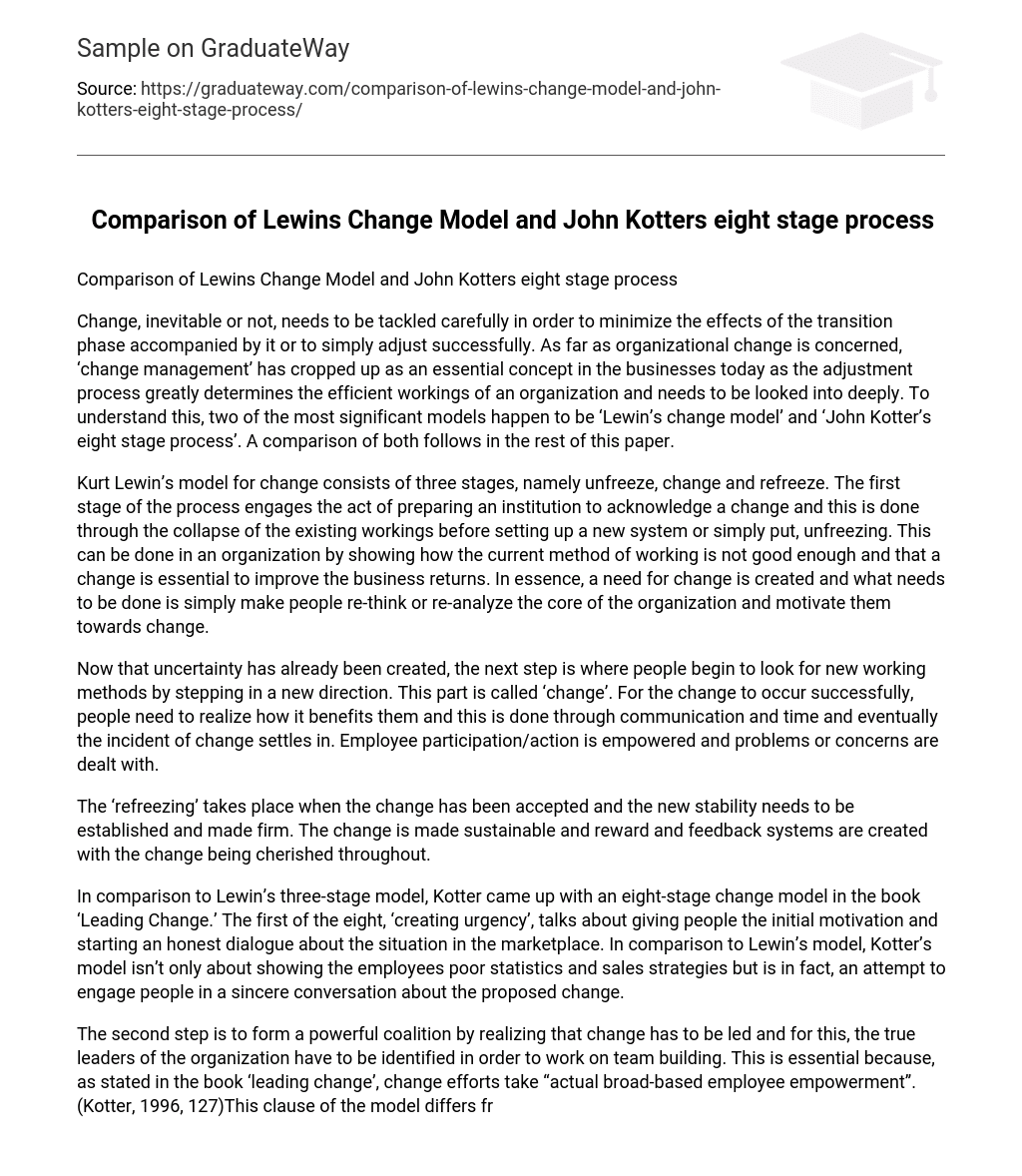Change, whether inevitable or not, should be approached with care to minimize the effects of the transition phase. In the context of organizational change, change management” has become essential in modern businesses. The adjustment process greatly influences an organization’s efficiency and requires careful consideration.
To understand this concept better, two significant models are Lewin’s change model and John Kotter’s eight-stage process. This paper will compare both models.
Kurt Lewin’s model for change consists of three stages: unfreeze, change, and refreeze. The first stage involves preparing an institution to acknowledge the need for change by dismantling the existing system before setting up a new one – this is known as unfreezing. In an organization, this can be achieved by demonstrating how the current method of working is inadequate and that a change is necessary to improve business returns. Essentially, creating a need for change requires people to rethink or reanalyze the core of the organization and motivate them towards making changes.
Now that uncertainty has already been created, the next step is to look for new working methods by stepping in a new direction. This part is called ‘change’. For change to occur successfully, people need to realize how it benefits them. This can be done through communication and time, and eventually, the incident of change settles in. Employee participation and action are empowered, and problems or concerns are dealt with.
Refreezing occurs after the change has been accepted and the new stability needs to be established and reinforced. This involves creating sustainable systems for feedback and rewards that support the change, which is then valued throughout.
In comparison to Lewin’s three-stage model, Kotter developed an eight-stage change model in his book ‘Leading Change.’ The first stage, ‘creating urgency,’ emphasizes the importance of providing people with initial motivation and initiating an honest dialogue about the market situation. Unlike Lewin’s model, Kotter’s approach is not solely based on presenting employees with poor statistics and sales strategies. Instead, it aims to engage individuals in a genuine conversation about the proposed change.
The second step in managing change is to form a powerful coalition. This involves identifying the true leaders within the organization and working on team building. It is essential to understand that change must be led, as stated in Kotter’s book ‘Leading Change’, which emphasizes the need for actual broad-based employee empowerment” (Kotter, 1996, 127). This aspect of the model sets it apart from Lewin’s model, which does not address teamwork or coalition formation despite their significant role in change management.
Moving on, the third step is to create a vision for change. This step, along with the fourth step of communicating the vision, is somewhat similar to Lewin’s unfreezing” step which also emphasizes communicating the vision. Both models stress addressing people’s issues and concerns about proposed changes; however, only Kotter talks about creating a separate vision before communicating it. He identifies both steps individually and gives separate importance to each.
The fifth step in Kotter’s model is to remove obstacles. This step involves checking for barriers that may appear as processes or structures and then getting rid of them. By doing so, employees who are required to execute the change are empowered. In comparison to Lewin’s model, this step is completely new and isn’t addressed in Lewin’s three stages of change. Removing obstacles is an essential part of the change process and must be given importance, which is only seen in Kotter’s model.
Creating short-term wins is the sixth step in Kotter’s change model. It refers to producing results that the staff can see by striving to achieve short-term goals. This gives the team a taste of victory and keeps them motivated toward the change. This practical way of supporting the change process is not mentioned in Lewin’s model.
The seventh step is a continuation of the sixth and discusses the process of building upon the change. Essentially, this involves setting additional goals to further capitalize on the momentum that has already been achieved.
The final step is to anchor the changes in the corporate culture. This involves ensuring that the change is evident in every aspect of the organization and that company leaders continue to support it. It is also important to celebrate the successes of the change, as mentioned in Lewin’s final step of ‘refreezing’.
A comparison between Lewin’s three-stage model and Kotter’s eight-step model reveals that while Lewin provided a general overview of the change process, Kotter offered a more detailed analysis. Both models share similar content, but Kotter delves deeper into the issue by breaking down the process into smaller steps and identifying even the smallest details involved. In contrast, Lewin included most of Kotter’s steps within his three basic headings.
References:
- Kotter, John P. (1996). Leading Change. Boston, MA: Harvard Business School Press. pp. 127.
- Ritchie, Bronwyn (2006). Lewin’s Change Management Model: Understanding the Three Stages.” Leading Change. Harvard Business School Press. Retrieved from http://www.consultpivotal.com/lewin’s.htm.





